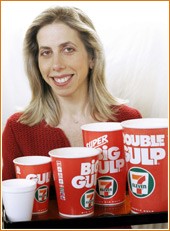Below is my latest blog post for Huffington Post “Bloomberg’s cap on supersize soda may be contagious”.
You can also read it HERE.
As Mayor Bloomberg prepares to leave office, his controversial proposed cap on the size of sugar-sweetened drinks may be contagious. While we wait for the courts to determine whether or not a 16-ounce soda will be the default “large” at eating establishments such as fast food restaurants delis, and movie theaters, the United Arab Emigrates (UAE) has decided to ban supersize sodas.
According to Arabian Business:
The UAE has banned supersized fizzy drinks as part of a raft of new health measures announced by the government, as the Gulf state looks to reign in burgeoning obesity and lifestyle disease rates. The federal cabinet came to the decision following the second day of what it described as a “brain-storming” session at a Sir Bani Yas island, and comes on the back of a similar idea being introduced in New York City earlier this year by mayor Michael Bloomberg. According to a recent United Nations report, more than one third of the UAE’s population is classified as clinically obese, while a separate study said that 20 percent of adult Emirati citizens suffer from diabetes.
In Europe, James Quincy, the president of Coca-Cola Europe, acknowledged that many soda sizes are too large. Appearing on BBC, Quincy said that the size of some of the large cups that Coca-Cola is sold in “needs to change” and that “the bigger cups need to come down.” And the sizes of European portions, including soda, are not nearly as large as our portions.
Meanwhile, back in New York City, at a recent roundtable sponsored by the Museum of Food and Drink debating the proposed cap on sugary beverages, I debated the merits of Bloomberg’s proposal. As discussed in Food Navigator, one of the reasons I support the proposed portion cap is that the marketing of supersize sodas has become the norm. In the movie theater, for example, a 32-ounce quart size soda is labeled “small” and a 44-ounce soda is labeled “medium.” Since when is a quart of soda considered small? I also discussed that obesity rates have increased in parallel with growing soda sizes and that calorie labeling alone will not solve the problem. Consumers need an environment that encourages healthier choices. And the healthy choice must be the easy choice.
As I further discussed in the debate and previously wrote in the NY Daily News:
Large portions contribute to obesity because they obviously contain more calories than small portions: A small soda (16 ounces) at KFC contains 180 calories, while the Mega Jug (64 ounces) contains nearly 800 calories — and is more than one-third of an entire day’s recommended calories for some people … Bloomberg is not banning the sale of soda. Nor is he telling consumers that they can’t drink soda. Rather, he is calling attention to how much is a reasonable amount to drink at a time. Sixteen ounces is certainly more than reasonable — a full pint of sugar water. Instead of viewing this as a ban, let’s see it as an attempt to reset the norm for how much soda truly constitutes an appropriate portion.
You can listen to the entire debate complements of Heritage Radio Network.
I hope that the courts favor Bloomberg’s proposal and that when we visit a concession stand at a NYC movie theater later in 2014, the largest single-serve soda is 16 ounces as opposed to the 50-ounce size available now.




